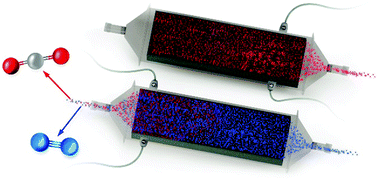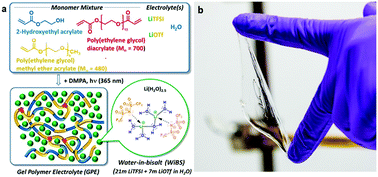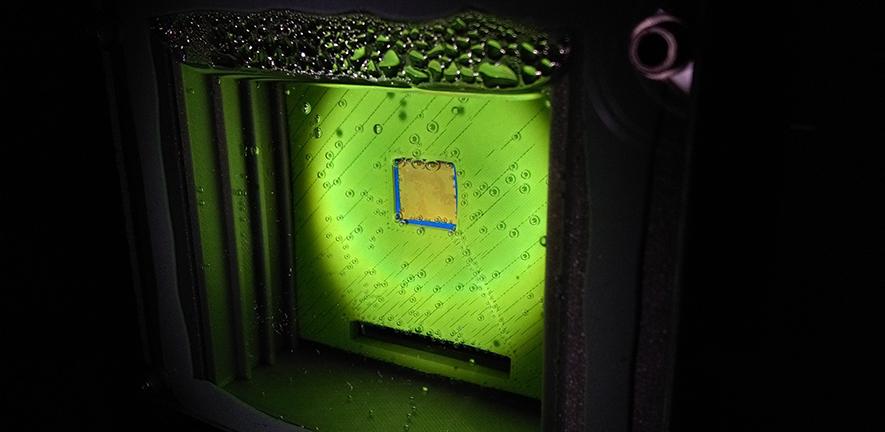(MIT engineers develop a new way to remove carbon dioxide from air)
2019/10/24 アメリカ合衆国・マサチューセッツ工科大学(MIT)
・ MIT が、充電と放電によりあらゆる濃度の CO2 を吸着捕獲・放出する、バッテリータイプの CO2 除去システムを開発。
・ ガス気流等から CO2 を除去する方法の多くでは、化石燃料を使用する発電所からの燃焼排ガスのような高濃度ガスのみが適用。空気のような低濃度に対応する方法も開発されているが、同新システムは CO2 濃度を問わず、捕獲量 1 トン当たり約 1 ギガジュールの高効率電力消費、室温・常気圧下で作働し、低コスト。
・ 同システムのデバイスは、基本的には大型の特殊化したバッテリー。スタックされた薄い電電気化学シートセルが、充電サイクルでは CO2 を含んだ空気やフィードガスを取り込み、電極で CO2 を吸収。放電サイクルで高純度・高濃度の CO2 を放出する。
・ カーボンナノチューブ化合物のポリアントラキノンでコーティングした同電極は、CO2 への親和性を備え、充電時の電気化学反応では極めて低濃度の CO2 分子にも反応する。放電時の逆反応では、システム全体が要する電力を部分的に供給して高純度 CO2 ガスを放出する。
・ 充電・放電で切り替わる同電極の CO2 への親和性と疎外性が、他の炭素捕獲・吸収技術には無い有利な点。同電極のこのバイナリーな働きにより、あらゆるガス濃度から CO2 を捕獲し、あらゆる純度・濃度の CO2 を放出する。
・ 例えば、炭酸飲料用の高純度の CO2 が必要な場合、高純度ガス気流から CO2 を捕獲し、高純度の CO2 を放出できる。化石燃料を使用せずに、ソフトドリンク製造工場や温室用の CO2 生成や、大気中の温室効果ガス削減プロセスが可能に。
・ また、常に排ガスを生成する発電所に同システムを 2 セット導入すれば、セル 1 は燃焼排ガスを取り込んで CO2 を捕獲する充電サイクル、セル 2 では CO2 放出の放電サイクル、という交互運転により、継続的な CO2 捕獲と放出が可能に。研究室での同システムの実験では、経時的な効率性の低減率が 30%で、最低で 7,000 充放電サイクルの耐久を実証。20,000~50,000 サイクルまで向上が可能と予測。
・ 同システムの電極は、標準的な化学プロセスで製造できる。現在は研究室レベルだが、将来的には電極 1 ㎡当たり数十ドルの低コストで、ロール・ツー・ロールプロセスによる大量製造が可能と考える。
・ 同技術の商業化に向けて Verdox 社を設立。数年内でのパイロットスケールプラント建設を見込む。同システムは電極の増設で容易にスケールアップできる。
URL: http://news.mit.edu/2019/mit-engineers-develop-new-way-remove-carbon-dioxide-air1025
(関連情報)
Energy & Environmental Science 掲載論文(フルテキスト)
Faradaic electro-swing reactive adsorption for CO2 capture
URL: http://dx.doi.org/10.1039/C9EE02412C
<NEDO海外技術情報より>
Abstract
Carbon capture is one of the foremost methods for curtailing greenhouse gas emissions. Incumbent technologies are inherently inefficient due to thermal energy losses, large footprint, or degradation of sorbent material. We report a solid-state faradaic electro-swing reactive adsorption system comprising an electrochemical cell that exploits the reductive addition of CO2 to quinones for carbon capture. The reported device is compact and flexible, obviates the need for ancillary equipment, and eliminates the parasitic energy losses by using electrochemically activated redox carriers. An electrochemical cell with a polyanthraquinone–carbon nanotube composite negative electrode captures CO2 upon charging via the carboxylation of reduced quinones, and releases CO2 upon discharge. The cell architecture maximizes the surface area exposed to gas, allowing for ease of stacking of the cells in a parallel passage contactor bed. We demonstrate the capture of CO2 both in a sealed chamber and in an adsorption bed from inlet streams of CO2 concentrations as low as 0.6% (6000 ppm) and up to 10%, at a constant CO2 capacity with a faradaic efficiency of >90%, and a work of 40–90 kJ per mole of CO2 captured, with great durability of electrochemical cells showing <30% loss of capacity after 7000 cylces.




